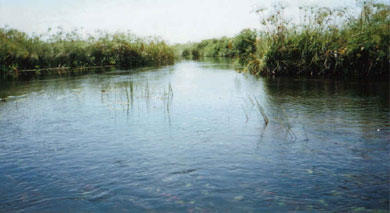Okavango Delta, Botswana
 Sometimes called a 'swamp', the image such a word conjures does not do justice to the beauty of the Okavango Delta, one of the world’s largest inland water systems. Moving, mysterious, placid and beautiful, the Okavango morphs from a wide and winding river called the Cubango with its headwaters in Angola’s western highlands, which then flows through Namibia where it is called the Kavango, until it finally enters Botswana, where it is then called the Okavango.
Sometimes called a 'swamp', the image such a word conjures does not do justice to the beauty of the Okavango Delta, one of the world’s largest inland water systems. Moving, mysterious, placid and beautiful, the Okavango morphs from a wide and winding river called the Cubango with its headwaters in Angola’s western highlands, which then flows through Namibia where it is called the Kavango, until it finally enters Botswana, where it is then called the Okavango.
Millions of years ago the Okavango used to flow into a large inland lake called Lake Makgadikgadi (now Makgadikgadi Pans). However tectonic activity and faulting interrupted the flow of the river causing it to backup and form what is now the Okavango Delta. At the delta the Okavango fans out into a series of tiny channels that creep their way along a wall of papyrus reed, into an ever expanding network of increasingly smaller passages. The channels link a series of lagoons, islands, open grasslands and flooded plains in a wonderous mosaic of land and water. This unique system of water ways supports a vast array of animal and plant life that would have otherwise been a dry Kalahari savanna. Palms and towering trees abound, throwing their shade over crystal pools, forest glades and grassy knolls.
The overall length of the delta from the border to the Thamalakane River is a little under 300kms, and the cone of the delta is approximately 200km from end to end. The delta varies in size depending on the local rainfall and rainfall in Angola. The Angolan rains start in October and finish in April, flooding the Cubango. The floods cross the border between Botswana and Namibia in December, finally reaching the delta in July, a nine month journey. The slow, meandering pace of the flood is due to the lack of drop in elevation, which drops a little more than 60 metres over a distance of 450 kilometres. The delta’s water deadends in the Kalahari – via the Botetle river, with over 95 per cent of the water eventually evaporating. At the driest time of the year the flooded portion is only 6 000km2, and there is geomorphological evidence to show that in times past the delta may have been larger than 22 000 square kilometres.
As the water fills the delta, wildlife starts to move back into the region. Rare species such as crocodile, red lechwe, sitatunga, elephant, wild dogs, buffalo, wattled crane can be seen, as well as more common mammals and bird life. The best time for game viewing in the delta is during the May-October period, as the animal life is concentrated along the flooded areas. Conversely, the best time for viewing birdlife and vegetation is during the rainy season (Nov.- April) as the migrant bird populations are returning and the plants are flowering and green. More than 350 bird species are to be found and guides at any one of the dozen or more camps are very good at providing unparalleled advice for serious bird watchers.







